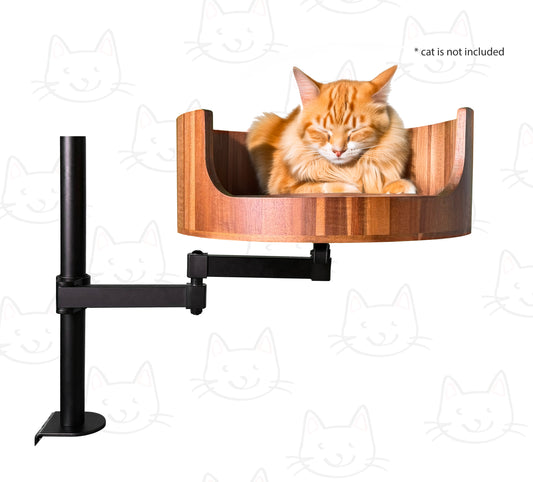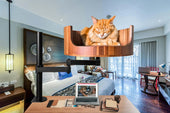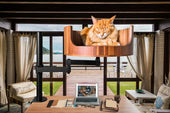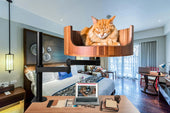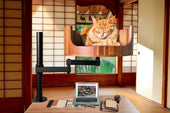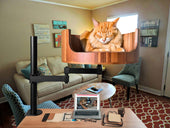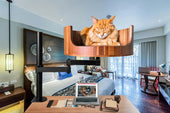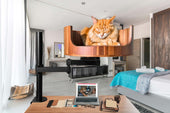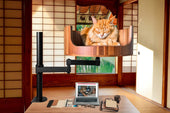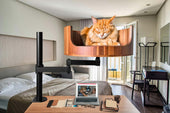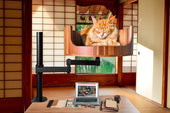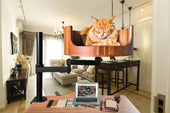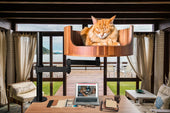
Why is my cat's tail vibrating: Understanding the Behavior
Share
Ever noticed your cat's tail vibrating uncontrollably while they are in a particular environment or situation? This odd behavior can be puzzling for cat owners, but fear not - it's actually a common phenomenon that can reveal valuable insights into your feline friend's state of mind. In this article, we will delve into the fascinating world of cat behavior, specifically focusing on why your cat's tail may be vibrating and what it means for their overall well-being.
One of the key behaviors we will explore is the Desk Cat Nest, a popular trend among feline companions that involves curling up in a cozy spot while exhibiting subtle tail movements. Understanding why cats engage in this behavior can provide valuable information about their emotional state and needs. Additionally, we will discuss how cat tail vibrations can indicate excitement, anxiety, or even aggression, allowing you to better interpret your cat's body language and provide appropriate care and support. Stay tuned as we unravel the mysteries behind your cat's tail vibrations and gain a deeper understanding of their unique communication methods.
- A cat's tail vibrating can indicate various emotions, such as excitement, fear, or stress.
- Pay attention to your cat's body language and surrounding environment to understand the reason behind the tail vibration.
- Factors like physical discomfort, playfulness, or nervousness can also contribute to a cat's tail vibrating.
- Cats may use tail vibrations as a form of communication with other animals or humans.
- If the tail vibrating persists or is accompanied by other concerning behaviors, consult a veterinarian to rule out any underlying health issues.
Reasons for Tail Vibrating
There are several reasons why a cat's tail may vibrate, ranging from excitement and happiness to anxiety and fear. One common reason for tail vibrating is when a cat is feeling particularly happy or excited, such as when they see their favorite human or receive a special treat. On the other hand, tail vibrating can also be a sign of fear or anxiety, especially if the cat is exposed to a new environment or situation that makes them feel uncomfortable. It's important to pay attention to your cat's body language and the context in which the tail vibrating occurs to better understand their behavior.
Communicative Function
Tail vibrating is a form of communication for cats, used to convey their emotions and intentions to other animals or humans. For example, a cat may vibrate their tail rapidly when they are feeling agitated or frustrated, signaling to others that they need space or want to be left alone. On the other hand, a slow and gentle tail vibration can indicate contentment and relaxation, showing that the cat is feeling comfortable in their environment. By paying attention to your cat's tail movements, you can better understand their needs and emotions.
Medical Conditions
In some cases, tail vibrating can be a sign of an underlying medical condition that requires attention from a veterinarian. For example, neurological disorders or injuries can cause abnormal tail movements, such as constant vibrating or twitching. It's important to monitor your cat's tail behavior and seek veterinary advice if you notice any unusual or persistent tail vibrations. A thorough examination and diagnostic tests can help identify the cause of the vibrating tail and provide appropriate treatment to improve your cat's health and well-being.
Desk Cat Nest FAQ
Why is my cat's tail vibrating?
There are several reasons why your cat's tail may be vibrating. It could be a sign of excitement, fear, stress, or even a medical issue. Observing your cat's body language and behavior can help determine the cause of the tail vibrating.
Can using Desk Cat Nest help with my cat's vibrating tail?
While Desk Cat Nest is primarily designed as a comfortable resting spot for cats, providing a safe and cozy environment can help reduce stress and anxiety in your cat, which may in turn help alleviate the vibrating tail behavior.
How should I introduce my cat to Desk Cat Nest?
It's best to place Desk Cat Nest in a quiet and comfortable area where your cat likes to spend time. You can encourage your cat to explore the nest by placing treats or toys inside. Allow your cat to approach the nest at their own pace and make sure it feels safe and inviting for them.
Are there any tips for keeping my cat calm and relaxed while using Desk Cat Nest?
Creating a peaceful environment with soothing music, pheromone diffusers, and regular playtime can help keep your cat calm and relaxed while using Desk Cat Nest. Additionally, providing your cat with plenty of attention and affection can help strengthen the bond between you and your furry friend.
In conclusion, if you are experiencing your cat's tail vibrating and want to provide them with a comfortable and safe space to relax, the Desk Cat Bed is the perfect solution. This innovative and cozy bed not only offers a secure spot for your feline friend to unwind but also provides them with a soothing environment to help alleviate stress and anxiety, which may be causing their tail to vibrate. With its plush cushioning and elevated design, the Desk Cat Bed is a valuable choice for promoting your cat's well-being and enhancing their overall quality of life. Invest in this fantastic product today to see the difference it can make for your beloved pet.

